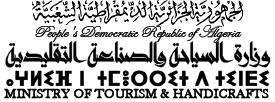Saida History and Civilization:
Saida is considered the gateway to the desert with its location as a pivotal area in the transit movement that links the north with the high plateaus and the south, in addition to its abundance of water. Tifrit and Wade Saida.
The Islamic conquests appeared in the Saeed area around the year 700 AD during the period of the rule of the Umayyad dynasty, and it became affiliated with the rule of the Rustamids (between the year 776 AD – 908 AD) and then it was ruled by the Almoravids since the year 1080 AD and the Almohads and the Zayans in the year 1235 AD.
Saida was called in the past by “Qursif” and this name extended from before the Islamic era until the rule of the Fatimids, when the tribes of Bani Hilal who established the Jacobite sect in it entered it.
In the nineteenth century (19 AD) Prince Abdul Qadir named the fortress he built “Saida” known as “Old Saida” between the years 1837-1839 AD, and on October 22, 1841, the Saida area was occupied by the French colonialists.
Saida is located on the western side of the country, about 470 km away from the capital of the republic. It occupies an area of 6,613 km2 with (06) departments and (16) municipalities. Saida falls within the framework of the states of the western high plateaus. According to the administrative division of 1985, the boundaries of the state became as follows:
From the north: the state of Mascara.
From the south: Wilayat El Bayadh.
From the east: Tiaret.
From the west: Sidi Bel Abbes.
The population of Saida, according to the latest statistics, is about 322,862 people, with a population density of 46.97 people / km2.
Natural and geographical features:
The Wilayat of Saida is characterized by its continental climate (semi-arid, hot in summer, cold in winter). It is also characterized by two different regions: from the north the Al-Dhaya mountains, and from the south the high plateaus.
A happy area is a geographical mixture in which mountains and forests of breathtaking beauty, flowing waterfalls, and caves that tell about the region’s age, so that
it appears as a wonderful painting whose colors harmonized and fused into a natural, homogeneous and attractive form. Atrous, Mount El Labba, as well as waterfalls, the most famous of which is the Tiferet waterfall, which is an important tourist destination for its natural and aesthetic privacy, as well as a small waterfall in the Hunt Valley.
| N° | Designation | localization | Advantages |
|---|---|---|---|
| 1 | Ogbane forest | Saida city | Dedicated to picnics, tourist tours and practicing sports, as well as a fresh water source and rich in archaeological, historical and cultural landmarks |
| 2 | El m’kimen forest | Saida city | It is a vast area of trees that allow the visitor to picnic, relax and exercise. |
| 3 | El brdj forest | Saida city | Dedicated to picnic, exercise and sightseeing |
| 4 | Berbour forest | Youb city | It is a dense forest with trees dedicated to tours and camping. |
The state of Saida is characterized by the abundance of plains, forests, mountains and valleys, which has given it a harmonious natural appearance that is capable of making it a region rich in climatic tourism products such as roaming in nature, camping, hunting and mountain sports. Mountain gazelles, green ducks, rabbits and a significant number of protected and endangered animals such as the striped hyena and the Atlas gazelle,… In addition, it has a rich vegetation cover such as Aleppo pine, oak, cork, and wormwood. Clitus….
About 300 species of medicinal plants were counted, through the establishment of protected steppe oceans, and steppe medicinal plants include many species, including wormwood, rosemary, watercress, marrow, local picking and steppe phyllo, thyme, vegell, and juniper. These species are of economic importance. It is ecologically and ecologically across the regions of Al-Mukamin and Stoning for punishment of the municipality of Al-Maamoura, Ben Hawar, the municipality of Ain Sokhuna, the Tavernet area of the municipality of Sidi Omar and is used to treat many human diseases, including kidney diseases, influenza, infectious diseases and dental pain.
For reference, the state of Saida is among the most important steppe areas that are rich in this medicinal plant wealth thanks to its limestone soil that helps the growth of these plants. The area of the steppe lands in the state is 120 thousand hectares.
Saïda city has a significant water wealth of mineral water, which is why it was called the “Mineral Water City” This wealth, which is the true symbol of the state over the past years, and the mineral “Saida water bottle” continues throughout all parts of the country, and no matter how many labels for different types of water springs occupy a reputation National, special and distinct due to the echo it achieved at the time.
Saida also has other exploited mineral sources, including: – Safed source, in addition to untapped sources, including: – Ain el-Bayda – Oum el-Rakhayel – Oyoun Al-Branis source, which has curative properties.


